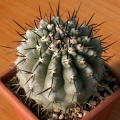
Copiapoa cinerea Photo by: Raimondo Paladini
Blooming habit, Chile, January 2017.
This is one of the most popular and attractive of the Copiapoas, due to its ash-grey to white coloured epidermis with typically black spines and wooly crown when mature. Unfortunately it is also slow growing, and therefore one of the most sought-after species in cultivation.
Origin and Habitat: Antofagasta, Chañaral regions of northern Chile.
Habitat: Coastal areas of South America, where it grows in areas where very little else grows. It's a very drought tolerant species. Despite the lack of rain where it lives, the extreme aridity is attenuated by the frequent, often dense, coastal fogs. The fog tends to concentrate in the form of a cloud band at an estimated height of 500 to 850 m. It shows a recurrent pattern; usually it is overcast in the early mornings, the clouds dissipating during the late morning and returning during the late afternoons. Even though the temperatures are moderate in the summer as well, the light on sunny days is so bright and burning that most Copiapoas are covered by a white waxy surface which protects the plants from the sun and reduces the evaporation. The wax gives the plants a characteristic, whitewashed look. The waxy coating is only created if the plants are exposed to ultraviolet rays and will only be created sporadically under glass in a greenhouse.
Synonyms:
See all synonyms of Copiapoa cinerea
Common Names include:
LITHUANIAN (Lietuvių): Pilkasis miglinėlis
SPANISH (Español): Copiapoa de Philippi
SWEDISH (Svenska): Grå randkaktus
UKRAINIAN (Українська): Коп'япоа попеляста
Description: Copiapoa cinerea is one of the most admired species of cacti with chalky/white stems covered with wool at the apex, which contrasts well with the sparse, jet-black spines. It is a solitary, or slowly offsetting, globular to columnar cactus. It is an extremely variable species with many forms, sometimes with long spines or others spineless like Ritter's "tenebrosas".
Stems: Up to 1,2 m tall, 10-20 cm in diameter. The white coloration is a waxy coating presumably to prevent dessication in it's extremely dry environment. In cultivation the white waxy bloom is often not produced, revealing a brownish epidermis.
Ribs: 12-30 broad, obtuse.
Central spines: 1 or 2 up to long, terete, black.
Radial spines: 0 to 7
Flowers: Yellow funnelform, 1,5 to 2,5 cm in diameter, occasionally with a pink or reddish tint. The Ovary is naked.
Blooming season: Summer, it needs a lot of sunlight to bloom, so it's pretty rare to have blossoms when in cultivation in greenhouses. It is not unusual for copiapoa to take 6-10 years before it starts blooming, but once it does, it should every year.
Fruit: 1,5 to 2 cm long.
Seeds: Black and shining.
Notes: This is a very variable species, as is demonstrated by the number of varieties and their synonyms. The several classifications and reclassifications provide evidence of the confusion that rules regarding the names used in this highly variable species. It seems that many of botanists and hobbyists who have studied Copiapoa in habitat have formed their own concepts of what names should be applied to which plants. It is relatively easy to attribute some key features that dominate in certain populations, but it is equally possible to look more closely at plants in these populations, to find individuals that 'break the rules' and would easily fit another population's dominant characteristics.
Bibliography: Major references and further lectures
1) Edward Anderson “The Cactus family” Timber Press, Incorporated, 2001
2) James Cullen, Sabina G. Knees, H. Suzanne Cubey "The European Garden Flora Flowering Plants: A Manual for the Identification of Plants Cultivated in Europe, Both Out-of-Doors and Under Glass" Cambridge University Press, 11/Aug/2011
3) David R Hunt; Nigel P Taylor; Graham Charles; International Cactaceae Systematics Group. "The New Cactus Lexicon" dh books, 2006
4) N. L. Britton, J. N. Rose “The Cactaceae. Descriptions and Illustrations of Plants of the Cactus Family.” Volume 4, The Carnegie Institution of Washington, Washington 1923
5) Urs Eggli, Leonard E. Newton “Etymological Dictionary of Succulent Plant Names” Birkhäuser 2004.
6) F.Ritter “Kakteen Südamerika” 3: 1072 1980.
7) Graham Charles “Copiapoa” Cirio Pub. Services, 1999
8) Adriana Hoffmann “Cactáceas en la Flora Silvestre de Chile” 1st edition, 1989
 LAU 818 (Collector: Alfred Bernhard Lau) Cifunchos, Antofagasta, Chile Altitude: 20-300m (together with L817, L819, L823 ) Photo by: Valentino Vallicelli
LAU 818 (Collector: Alfred Bernhard Lau) Cifunchos, Antofagasta, Chile Altitude: 20-300m (together with L817, L819, L823 ) Photo by: Valentino Vallicelli Copiapoa cinerea Photo by: Valentino Vallicelli
Copiapoa cinerea Photo by: Valentino Vallicelli Copiapoa cinerea Photo by: Valentino Vallicelli
Copiapoa cinerea Photo by: Valentino Vallicelli Copiapoa cinerea Photo by: Valentino Vallicelli
Copiapoa cinerea Photo by: Valentino Vallicelli AW115 Photo by: Cactus Art
AW115 Photo by: Cactus Art Copiapoa cinerea Photo by: Valentino Vallicelli
Copiapoa cinerea Photo by: Valentino Vallicelli KK92 (Collector: Karel Kníže) Taltal, Chile, 100-200m Photo by: Valentino Vallicelli
KK92 (Collector: Karel Kníže) Taltal, Chile, 100-200m Photo by: Valentino Vallicelli AW84 (carrizalensis?) Photo by: Valentino Vallicelli
AW84 (carrizalensis?) Photo by: Valentino VallicelliCultivation and Propagation: This cactus is kept for the beauty of its form. It is a summer grower species slow but easy to cultivate that like many cacti of the Peruvian deserts, present some problems in cultivation. It is in fact somewhat rot prone if kept in a non ventilated place.
Growth rate: It is a relatively rapidly growing and easily flowering species that will make clumps given the best conditions.
Soils: It likes very porous standard cactus mix soil, but can become too elongated if compost is too rich.
Repotting: Use pot with good drainage.
Watering: Water regularly from Spring to Autumn, but do not overwater and let the soil mix dry between waterings (Rot prone), keep dry in winter.
Fertilization: Feed with a high potassium fertilizer in summer.
Hardiness:Keep warm and dry in winter (10°C) to avoid rot. Not highly tolerant of a great deal of frost. (Frost tolerance 0°C)
Exposition: Requires full sun or light shade and careful watering to keep plant compact with strong coloured spines. Tends to bronze in strong light, which encourages flowering and heavy spine production. It must be protected from excessive heat and sun in summer.
Uses: It is an excellent plant for container growing. It always looks good and stays small. It look fine in a cold greenhouse and frame or outdoor in a rockery.
Pests & diseases: It may be attractive to a variety of insects, but plants in good condition should be nearly pest-free, particularly if they are grown in a mineral potting-mix, with good exposure and ventilation. Nonetheless, there are several pests to watch for:
- Red spiders: Red spiders may be effectively rubbed up by watering the infested plants from above.
- Mealy bugs: Mealy bugs occasionally develop aerial into the new growth among the wool with disfiguring results, but the worst types develop underground on the roots and are invisible except by their effects.
- Scales: Scales are rarely a problem.
It is wise to treat your whole collection with a systemic insecticide twice a year in spring and autumn.
- Rot: Rot is only a minor problem with cacti if the plants are watered and “aired” correctly. If they are not, fungicides won't help all that much.
Propagation: Seeds (or offsets if available) or by grafting onto a strong grafting stock like Selenicereus sp. Such grafted seedlings can be successfully cultivated for years. Grafting is often used to speed growth rate and to create a back-up to plants in collection. Seeds germinate in 7-14 days at 21-27° C in spring, remove gradually the glass cover as soon the plants will be well rooted (ca 1-2 weeks) and keep ventilated, no full sun for young plants!
Your Photos

by Valentino Vallicelli

by Cactus Art

by Valentino Vallicelli

by Cactus Art

by Cactus Art























